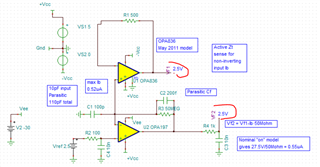- Ask a related questionWhat is a related question?A related question is a question created from another question. When the related question is created, it will be automatically linked to the original question.
This thread has been locked.
If you have a related question, please click the "Ask a related question" button in the top right corner. The newly created question will be automatically linked to this question.
Hi team,
My customer is evaluating OPA836 in a water meter project. This project cares about the power consumption very much. Customer found OPA836's Ib is as below:

This Ib value is too large for customer to accept. So I want to check with you the Ib value in above picture is tested when PD pin is low or high? If we pull PD pin to low to make the device into low power mode, can the Ib value be reduced in this situation? Thanks.
Best regards,
Wayne
Hi Wayne,
The Ib values you mention in your post represent normal operation for the OPA836.
Please see the below power down information (from section 7.0,7.7 of datasheet) for both 2.7V and 5V operation (so should be correct for various supply configurations):

As you can see here, the PD pin bias current is typically 20nA with a maximum of 500nA. The PD quiescent current is <1.5uA and typically 500nA. I believe these PD-specific specs are the information you are looking for. The Ib spec you referenced would be for normal operation; the stand-by current for the op-amp during power down is <1.5uA and varies by temperature as you stated.
Please let me know if I missed the mark on this or need to explain differently.
Also, could you share any additional customer requirements? Is there a bandwidth need or other spec which led to OPA836 consideration? We do have other high speed op-amps with lower Ib specs, though I am unsure of your customer's exact needs.
I hope this helps Wayne; you may also reach out to me via email if need be.
Best,
Alec
Also Wayne,
The OPA837 was done in many ways to improve on the OPA836. It is a little higher full supply current in shutdown but has faster turn on and turn off times - it also includes input stage features that allow direct wired or muxing of multiple channels.
The input stage current when shutdown should be very low unless you are driving it with enough input signal to turn on protection diodes.
If you don't need the speed of these two parts the lowest power single op amp with decent speed is the OPA2834 - apparently only dual and no disable.
Hi Michael,
Thanks for your reply. You mentioned ‘The input stage current when shutdown should be very low unless you are driving it with enough input signal to turn on protection diodes’.
In my customer's case, one of the input pin is connected to a voltage reference as a bias voltage. So the bias current will generate a power consumption on the voltage reference. So can we provide the exact Ib value when the device is in shutdown mode? Customer need this value to evaluate the total power consumption in shutdown mode. Thanks.
Best regards,
Wayne
Hey Wayne,
I got to thinking about how I might try to measure this. The disabled input Ib will not be in the TINA model nor is it an ATE test. I like to use active Zt sense stages for this kind of <1nA measurement. Here is a possible ckt using the low input bias current OPA197 - the OPA836 is a PNP input stage so active mode Ib flows out of the input pin, hence the +5V to -30V supplies on the OPA197

They have been getting rid of the shutdown in the models, but this old 2011 model still tried - very unlikely it will be accurate on Ib if I shut it down, but let's try,
It basically sims as 0 current in that summing node - meaning the OPA197 has 0 Ib in its model as well, and as I expected, the shutdown OPA836 model also has 0 Ib - physically not accurate, but it should be very low - this would allow someone to actually test this (over temp would be interesting) if they wanted to.

And the file with the Disable set to turn the part on,
Hi Wayne,
I agree with Michael's approach to modeling and investigating Ib behavior. If you would like more information on Ib values and test conditions please reconnect with me again over email.
Alec